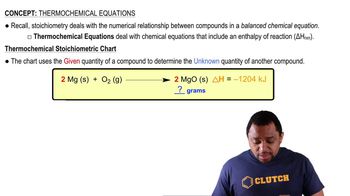Methanol (CH3OH) is used as a fuel in race cars. (b) Calculate the standard enthalpy change for the reaction, assuming H2O(g) as a product.
Ch.5 - Thermochemistry
Chapter 5, Problem 86
Ethane, C2H6, is an alkane with one C─C bond and six C─H bonds (Section 2.9). a. Use enthalpies of formation given in Appendix C to calculate Δ𝐻 for the reaction C2H6(𝑔)→2C(𝑔)+6H(𝑔). b. Use the result from part (a) and the value of 𝐷(C─H) from Table 5.4 to estimate the bond enthalpy 𝐷(C─C). c. How large is the difference between the value calculated for in part (b) and the value given in Table 5.4?

Verified Solution
Video duration:
3mWas this helpful?
Key Concepts
Here are the essential concepts you must grasp in order to answer the question correctly.
Enthalpy of Formation
Enthalpy of formation (ΔHf) is the change in enthalpy when one mole of a compound is formed from its elements in their standard states. It is a crucial concept in thermodynamics, allowing chemists to calculate the energy changes associated with chemical reactions. By using standard enthalpy values, one can determine the overall energy change for a reaction, which is essential for understanding reaction feasibility and stability.
Recommended video:
Guided course

Enthalpy of Formation
Bond Enthalpy
Bond enthalpy, or bond dissociation energy, is the energy required to break one mole of a specific type of bond in a gaseous molecule. It provides insight into the strength of chemical bonds and is used to estimate the energy changes during reactions. In the context of the question, bond enthalpy values are used to calculate the energy associated with breaking and forming bonds, which is vital for determining reaction enthalpies.
Recommended video:
Guided course

Enthalpy of Formation
Thermochemical Equations
Thermochemical equations represent the relationship between chemical reactions and the heat changes that accompany them. They include the enthalpy change (ΔH) for the reaction, allowing for the calculation of energy changes based on the bonds broken and formed. Understanding these equations is essential for solving problems related to energy changes in reactions, such as estimating bond enthalpies and comparing calculated values with tabulated data.
Recommended video:
Guided course

Thermochemical Equations
Related Practice
Textbook Question
758
views
Textbook Question
Methanol (CH3OH) is used as a fuel in race cars. (c) Calculate the heat produced by combustion per liter of methanol. Methanol has a density of 0.791 g/mL.
904
views
Textbook Question
Methanol (CH3OH) is used as a fuel in race cars. (d) Calculate the mass of CO2 produced per kJ of heat emitted.
461
views
Textbook Question
Use bond enthalpies in Table 5.4 to estimate H for each of the following reactions: (a)
958
views
Textbook Question
Consider the reaction 2 H2(g) + O2(g) → 2 H2O(l). (a) Use the bond enthalpies in Table 5.4 to estimate H for this reaction, ignoring the fact that water is in the liquid state.
499
views
Textbook Question
(b) A particular chip snack food is composed of 12% protein, 14% fat, and the rest carbohydrate. What percentage of the calorie content of this food is fat?
1241
views
